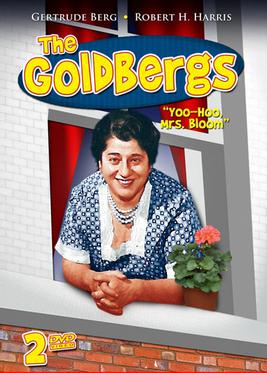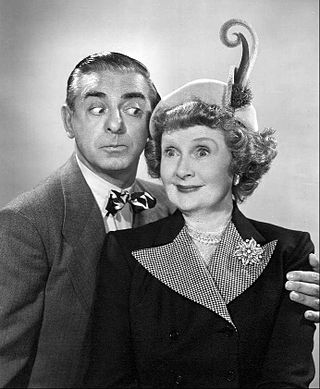
The DuMont Television Network was one of America's pioneer commercial television networks, rivaling NBC and CBS for the distinction of being first overall in the United States. It was owned by Allen B. DuMont Laboratories, a television equipment and television set manufacturer & broadcasting company. DuMont was founded in 1940 and began operation on August 15, 1946.

The Goldbergs is a comedy-drama broadcast from 1929 to 1946 on American radio, and from 1949 to 1956 on American television. It was adapted into a 1948 play, Me and Molly; a 1950 film The Goldbergs, and a 1973 Broadway musical, Molly. It also briefly spun off a comic strip from June 8, 1944, to December 21, 1945, with art by Irwin Hasen, a comic book artist who worked on various DC Comics titles and would later do the Dondi comic strip.
The 1947–48 United States network television schedule was nominally from September 1947 to March 1948, but scheduling ideas were still being worked out and did not follow modern standards. The schedule is followed by a list per network of returning series, new series, and series cancelled after the 1946–47 season.
Play the Game, also known as Let's Play the Game, was one of the earliest game shows to be broadcast over an American television network, and the first known example of a television panel show. In 1941-42, CBS aired an early game show, CBS Television Quiz.
The Gallery of Madame Liu-Tsong is an American television series which aired on the now defunct DuMont Television Network. It starred Chinese American silent film and talkie star Anna May Wong who played a detective in a role written specifically for her. The Gallery of Madame Liu-Tsong was the first U.S. television series starring an Asian-American series lead.
Front Row Center is the title of two American television programs with different formats that were broadcast on different networks.

Charlie Wild, Private Detective is an American detective series that aired on three of the four major American television networks of the 1950s.
This Is Music is an American music television series which was broadcast on the DuMont Television Network from November 29, 1951, to October 9, 1952.
Major Dell Conway of the Flying Tigers was an early American television program broadcast on the now defunct DuMont Television Network. The series ran from April 7, 1951, to March 2, 1952.

Treasury Men in Action is an American crime drama series broadcast live and which aired from September 11, 1950, through April 1951 on ABC and then on NBC through 1955. The series stars Walter Greaza, Ross Martin, and Tom McKee.
Academy Theatre is an American drama anthology television series that aired on NBC from July 25, 1949, to September 12, 1949. It ran for eight weeks as the summer replacement for Chevrolet on Broadway.
The Show Goes On was a variety show that aired in the United States on CBS from January 19, 1950, to January 16, 1952. Robert Q. Lewis was the host. After the debut episode, the program was broadcast on alternate Thursdays at 8 p.m. Eastern Time.
Joseph Schildkraut Presents is an anthology television series that originally aired on the DuMont Television Network starring stage and screen actor Joseph Schildkraut.

At Home With Billie Burke was a TV talk show starring Billie Burke which aired on the DuMont Television Network from June 1951 to the spring of 1952.
Magnavox Theatre is an American television anthology of comedies and dramas that aired seven hour-long episodes on CBS in 1950, alternating weekly with Ford Theatre. The first episodes were live, with filmed episodes later on. Episode six, according to CBS, was the first hour-long film made in Hollywood specifically for television. The film was made by Hal Roach Studios Inc., which also made "The Hurricane at Pilgrim Hill", which was the seventh and final episode, scheduled for broadcast on December 8, 1950.
Starlight Theatre is a 30-minute American television anthology series of romantic stories that aired on CBS from April 2, 1950, to October 4, 1951. Forty-nine episodes aired. In 1950-1951 it alternated with The George Burns and Gracie Allen Show.
The RCA Victor Show is a 1950s American television program broadcast on NBC that eventually became The Dennis Day Show. It began on November 23, 1951, and ended on August 2, 1954.
Big Town is an American television dramatic series that was broadcast beginning on October 5, 1950, and ending on October 2, 1956. It began on CBS and moved to NBC in 1954.





